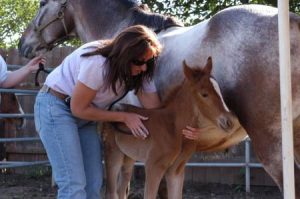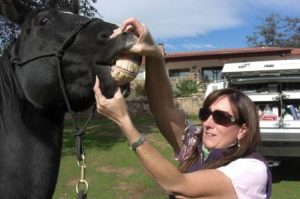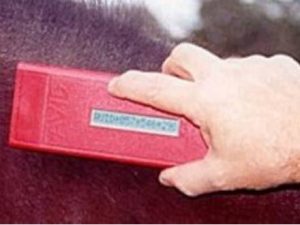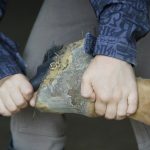A "cast" horse refers to one that is stuck on the ground for some reason-- either its legs are under a fence, or the horse has rolled up near a wall or object that prevents it from being able to get up. Sometimes a horse can become cast in a ditch or depression in the ground, and mares heavy in foal can be unable to rise if they roll and their legs are uphill fom their body.
Horses are not designed to spend long periods of time on the ground. Horses are able to sleep standing up, which is what they do most of the time. When they do lay down to sleep, its often for only a short time. When a horse is cast, it is at risk for injuries. Cast horses may panic and thrash, injuring themselves on a fence or wall. They can injure their eyes or neck when they struggle to get up. Horses down for long periods of time, especially those lying on their back, may actually suffocate from the pressure of their digestive system pressing against their lungs. Horses may become cast when they colic and try to roll, or may twist an intestine struggling to stand when cast.
Many horses that become cast can get themselves up with just a little help. They only need to be moved far enough away from a wall so that they can get their legs under them and struggle to their feet.
If your horse is cast, don’t panic. Look at the situation and see what needs to be done-- if the horse is against a wall, it may only need to be dragged a few inches away. Or, the horse may be flipped over so that it can stand. Be careful and stay away from the horse's legs-- a cast horse may panic or struggle to stand, especially when you begin to help him and he feels that he can stand on his own.
If your horse is stuck with their legs beneath a fence, see if you can first move the fence away (for example, if it is a portable panel that can be moved). If that can’t be done easily, you’ll need to get someone to help you drag the horse back.
Try to get a rope beneath them, or at least loop it under one leg and the neck so you aren’t pulling on the horse’s leg alone. You may be able to gently pull the horse's neck (and front end) away from the fence so that he can stand. Be careful that you don't injure the horse's eye when you drag him-- you may be able to place a towel, or lift his head as you pull him back. Horses can panic when cast, so you have to be careful that you aren’t struck with a flying hoof in the process. You should be able, using a rope, to drag the horse away. Horses are heavy so you will probably need another person or two to assist you.
Horses that have been properly sacked out (desensitized) will usually be much calmer in emergency situations than horses that haven’t. If a horse is thrashing, stay away from the hooves. You can still approach from the horse’s back and throw a rope around the leg. Don't ever tie a rope around the leg-- when the horse stands or struggles he can become caught up. Instead just loop it around and hold both ends of the rope, so it can be dropped quickly when the horse begins to stand.
The best way to free a horse, however, is to gently roll it over so that it can stand on its own. If its legs are under a fence, this won’t be possible, but if the horse has been cast by rolling up against a wall or other object, you can probably flip them over. Put a rope around each leg that is against the ground, and gently flip the horse over. It does not take much strength to do this, however you have to be careful not to get kicked. That is why you should use ropes, instead of just grabbing and flipping the horse over. When the horse gets flipped over it may struggle suddenly to stand, so make sure you aren’t in harm’s way.

















